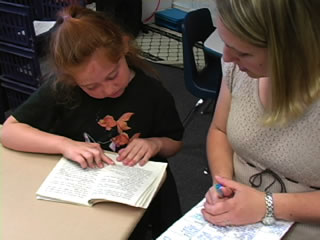Teaching
Practice: What's my approach?
The main idea behind all teaching that I do with my students
is constantly trying to meet the needs of all of my students through
differentiation instruction in a workshop format.
How did I come to develop this approach?
This approach to my teaching was developed through many
hours of staff development at my site with other teachers. It is
a philosophy that all teachers practice at our school. In addition,
I have read many professional resource books that support this
kind of teaching practice.
What were the outcomes I observe in my students?
One of the biggest outcomes I observed in my students work
is a strong understanding and focus of the curriculum that is being
taught. I feel that because the work they are focusing on connects
back to the mini lesson, they are able to make these connections
very easily. With the directed mini lesson, I have found my students
to be more successful at various tasks they are asked to do in
class.
What materials and strategies do you use to support your teaching
(especially those parts of your teaching represented in the website)?
I elaborate on this in the resources section
of the website.
The way I used to teach
Before I started teaching language arts through
the workshop approach, I had partner reading set up , and I wasn’t liking the way
it flowed. The kids seemed bored, and they weren’t really helping
one another, and I always understood partner reading to be one of
those where they can help each other, and they can reflect together. I
felt that it needed to be reevaluated. I also had literacy
centers, but the kids didn’t like it. They felt like it was
kind of busywork. The way we had it set up, we had it in 15 minute
increments, because my guided reading group was for 15 minutes each,
so when that group finished, the kids who were working in a center,
if they were the next group, they were never able to finish their
work. It was very frustrating for them.
Transforming my practice
The literacy coach came in, and we were talking
about it, and she said, “These kids want to read! They want to do more
independent reading! And we know that in order for them to get better,
we need to have them practice this more independent reading.” So
with that, we decided to eliminate centers. And we extended
our independent reading time. And I told her, “Sharon,
I don’t think they’re going to be able to read that long,” and
of course I was conferencing during that time, one on one, and I
did that for the first 15 minutes, and then I would call back the
first guided reading group. Guided reading is so critical in the
readers workshop, especially in second grade – they need that
differentiation, they need that one on one, too. So I
went and we tried it out, and they loved it, and they didn’t
miss it one bit. So halfway in the year, I changed the whole
thing on them, and they thrived. They thrived. So I’m
not going back to literacy centers again.
Learning to do Guided
Reading
Guided reading was actually introduced to me in
my credential program by Dr. Marilyn Chi. We had the book, we also had Word Matters. But
I didn’t really learn it and apply it until I was in my first
year of teaching, and we have a literacy coach on our site, and the
literacy coach literally came in to all of our rooms and modeled
for us lessons on “How to do a guided reading lesson.” And
we did staff development. My principal would give us release time,
and we’d go to different … for writers workshop we went
to different schools, but for readers workshop we went to go an observe
each other, we could go to any grade we wanted to, and I was able
to observe my colleagues teaching guided reading to students within
the normal school day as well as the literacy coach teaching in my
classroom to my own students, which was very nice. I also had
the literacy coach work with me for a three month period this year. IT
was one of those things at the end of the school year last year she
said, “I’m going to ‘go deep’ in four classrooms.” And
you had to apply, and I was one of the classrooms that was selected. So
she was in my classroom for readers workshop and writers workshop
and word study. And she would take readers workshop that day,
I would take writers workshop and we would observe each other teach.
It was amazing. Really. The literacy coach really moved my
teaching.
Transforming Faculty
Practice
One thing we
noticed as a staff, we noticed that first we started with writers
workshop, and then when we tried readers workshop, the whole structure was
the same. The kids loved it, they really thrived. So we thought,
if they’re thriving in readers and writers workshop, with this same structure,
I bet they would thrive in math too. And our kids are struggling in math.
They need more help in math. So we’ve focused for the last couple
of years on literacy, but now we need to come back. We have a lot of people
on staff who are trained through Noyce, and we also have some math gurus on
our staff. Our staff is really big into
staff development.
 Living
the Life of a Reader and Writer
Living
the Life of a Reader and Writer